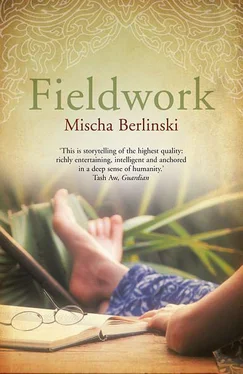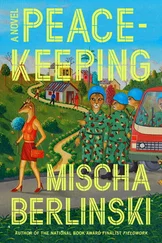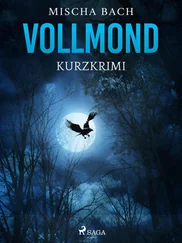"Wei shi shi ma?" she said, pointing at a dog.
"Bao."
"Wei shi shi ma?" she said, pointing at a basket.
"Rai baht nee."
"Wei shi shi ma?" she said, pointing at her teeth.
"Paht."
"Wei shi shi ma?" she said, getting up and walking a few steps.
"Bainai."
"Bao bainai?"
Big smiles. "Bao bainai!"
Yet even this fairly mechanical if laborious business proved a struggle: just learning the word for "rice," the most primal word of the Dyalo lexicon, had required a day. The three children she discussed the matter with gave her three different words, and when she asked Vinai what all the different words meant, he told her, "Rice." Martiya tried to think the problem through. Perhaps, she thought, it was a question of a particular type of rice. The production and consumption of rice was, after all, the central drama of Dyalo life. Martiya had read a book about rice in preparation for her voyage, and the world of rice was as variegated to the connoisseur as the world of wine: there was brown rice which hadn't been milled and white rice which had; normal rice, stickier rice, and very sticky rice; rice cultivated in knee-high paddies, in deep ponds, and on the dry slopes of high mountains; long-grain rice, medium-grain rice, and short-grain rice; rice whose seeds once came from Burma, rice whose seeds had been transported by the ancestors from old Dyalo homesteads in China; rice that was naturally resistant to caterpillars, and rice that was a caterpillar's delight. Martiya had expected that the Dyalo would have a number of words for rice. But that wasn't the problem here. The Dyalo did have words to describe all of those kinds of rice, but the words the children were using did, in fact, just mean "rice."
Nothing more and nothing less.
Same thing for the Dyalo word for "roof." Three words, one meaning.
And the Dyalo word for "water."
And the Dyalo words for "light," "rock," and "tree."
Gradually, very gradually, through numerous such frustrating examples, it dawned on Martiya that there were upwards up of three different lexicons all in use in the same Dyalo village, all under the linguistic penumbra of "Dyalo." A similar distinction exists in English when we refer to "pork" and "pigs": two words, one object, depending on the context. But in Dyalo this distinction was far more prevalent than in English: just about every noun had three forms. There was the lexicon of ordinary speech, as in "Would you pass the rice, please?" — which, incidentally, is not easy to say in Dyalo, a simple tonal error resulting in an extremely offensive sentiment; and the poetic lexicon, which the Dyalo tended to break into just whenever subjects of anthropological interest might arise, such as mythology, religion, history, law, government, or philosophical belief; and the spirit lexicon, reserved exclusively for descriptions of, and conversations with, supernatural beings. Martiya realized with dismay that she would need to learn all three if she was to understand the life of the village.
The problem in Dyalo wasn't just memorizing things or learning to mimic tones. Sometimes the language simply worked in weird ways. One day, Martiya decided to learn the names of colors. It seemed to her a sane, sensible, limited goal for a rainy morning in a very small hut. By chance, Martiya had brought a set of colored pencils with her up to the village, a present from her father, eighty colors lined up in two neat rows, with charcoal and an eraser. The lacquered box had been a source of constant fascination to the children, and she offered them, via Vinai, a bribe: they could play with her pencils if they would teach her the names of the colors. It would be hard to say who in the end was more frustrated. The problem, Martiya quickly learned, was that the Dyalo seemed to have no abstract color terms, words like "red" or "green," which cover a broad range of shades. Rather, the Dyalo color world was painfully precise. Every Dyalo color took its name from an object in the natural world. In Dyalo, the light green pencil was the pencil the color of moss. The dark green pencil was the pencil the color of palm. The red pencil was the pencil the color of betel. There were eighty pencils, and hence eighty distinct Dyalo colors, and amazingly, every Dyalo tribesman seemed in absolute agreement which object in the natural world corresponded to which color. When Martiya pointed to the white pencil and said it was the color of rice, she was immediately corrected: it was cloud. When Martiya protested that the green pencil was not, in fact, the color of moss, and demonstrated this with a piece of moss from a nearby tree, the entire hut burst into giggles. Of course not! It's the color of moss in dry season! The names were arbitrary and needed to be learned one by one. Needless to say, Martiya did not learn the Dyalo colors in a morning.
Martiya persevered. She began to get the hang of the tones, and her notebook slowly filled with Dyalo words and phrases, which she wrote in the international phonetic alphabet, using arrows to indicate tonality. This script was itself a source of wonder and fascination to the Dyalo, who had seen the clever lowland Thai write things down and then recall them later with perfect accuracy; but nobody in Dan Loi had ever imagined that the Dyalo language, too, could be handled the same way. Martiya's literacy was regarded as a remarkable skill, and there was considerable debate in the village how it was that Martiya, who could hardly say a word in Dyalo, could nevertheless write in the language, the latter of course being considered an infinitely more sophisticated achievement than the former: even the Lahu monkeys, after all, could learn to speak Dyalo, albeit always with that unpleasant Lahu accent. When Dyalo from other villages came to visit Dan Loi, Martiya was inevitably trotted out like a show pony to display her strange and impressive facility. It was considered excellent evening entertainment. "Tell my sister what I told you about her husband," Lai-Ma would say at a family gathering; and Martiya, eager to please, would flip through her hard-sided notebook and read back, in Lai-Ma's own words, just what Lai-Ma had said. The Dyalo simply could not get enough of this, "Koo-koo," they said, which was their way of saying, Brava! , like opera aficionados applauding a particularly impressive aria.
With time her father's genes asserted themselves, and Martiya made progress. She came to appreciate the flowery formalism of Dyalo, the polite phrases which made intimate village life possible. When she proposed to walk to the fields with Lai-Ma, she learned to say, "If I walk with you, will it slow your pace?" and anticipate Lai-Ma's shy, pained reply, "Certainly not. Add your legs to mine." Then Martiya would say, as Vinai had coached her one thousand times the night before, "The buffalo on four legs walks faster than the chicken on two," and they would set off. The Dyalo had a myriad of such set interrogatory phrases for every aspect of life, and there was something elegant, Martiya felt, in the polite verbal dance which accompanied the simple act of passing a cup of tea or excusing oneself from the room.
When both Martiya and the children grew restless in the mornings, and the children, long since bored with the name-a-thing game, started throwing clods of dirt at one another, Martiya would check in with Lai-Ma, her hostess. In Berkeley, they had been agreed: fieldwork should be done in the fields. Only after a long day of shared labor would a villager ever really look upon you as a sister, a goal which was already seeming to Martiya less desirable than it once had. Nevertheless, every morning Martiya would seek out Lai-Ma and make her ritual offer to help with household chores or work with her in the fields. The first dozen times Martiya offered, Lai-Ma had looked shocked. "But it is so boring to work in the fields," she said. "If I were rich like you, I'd never go into the fields." A few times, Martiya had insisted, and discovered immediately that Lai-Ma was right: working the fields was boring. It was hideously boring. It was backbreaking, slow, agonizing labor. Martiya spent a few days hunched over a hoe, and gouged a nice chunk out of her foot, which only through the grace of God did not become infected. Martiya came back to the village muttering that she'd never try that again, a decision widely approved of by the villagers: if there was any one point on which the people of Dan Loi were agreed, it was that field labor was strictly for the birds — or for the Lahu monkeys. There was a Lahu village just an hour's walk from Dan Loi, and all the villagers of Dan Loi who could afford it, rather than go into the fields themselves, tended to hire Lahu day workers. This was Martiya's first ethnographic discovery. As a Republican, Martiya thought this an eminently sensible system. When Martiya asked why the Lahu were willing to work the fields, she was told that it was because they were stupid, like monkeys; when she came to know the Lahu better, she agreed. She wondered how these observations would be received by her dissertation committee.
Читать дальше












